Abstract
Infection of mice with Trypanosoma gambiense induced a rapid and transient increase in levels of serum granulocyte-macrophage colony-stimulating activity (GM-CSA) followed by an increase in the numbers of circulating neutrophils and large mononuclear cells. Similar phenomena were observed in mice injected with a trypanosomal homogenate. In such mice, levels of GM-CSA were markedly elevated as early as 1-2 days after administration of the homogenate and then rapidly decreased. Numbers of circulating neutrophils and large mononuclear cells increased within 2 and 3 days after injection of the homogenate, respectively. Induction of GM-CSA by the trypanosomal homogenate promoted colony formation by normal spleen cells, but did not support colony formation by spleen cells from mice treated with 5-fluorouracil. Serum levels of GM-CSA were elevated by injection of crude trypanosomal membrane fractions, but not by soluble components found in supernatants from centrifuged trypanosomal homogenates. GM-CSA-inducing ability of the crude membrane fraction was sensitive to heating at 60 degrees C for 30 min, treatment at pH 2.0, pronase digestion, periodate oxidation, and exposure to 0.1% sodium dodecyl sulphate. This biological activity was also reduced by trypsinization of living trypanosomes before preparation of membrane fractions. These findings suggest that the active component of parasites to induce GM-CSA is associated with a glycoprotein in the surface coat of T. gambiense. GM-CSA may be related to the haematological and immunopathological alterations that occur in African trypanosomiasis.
Full text
PDF
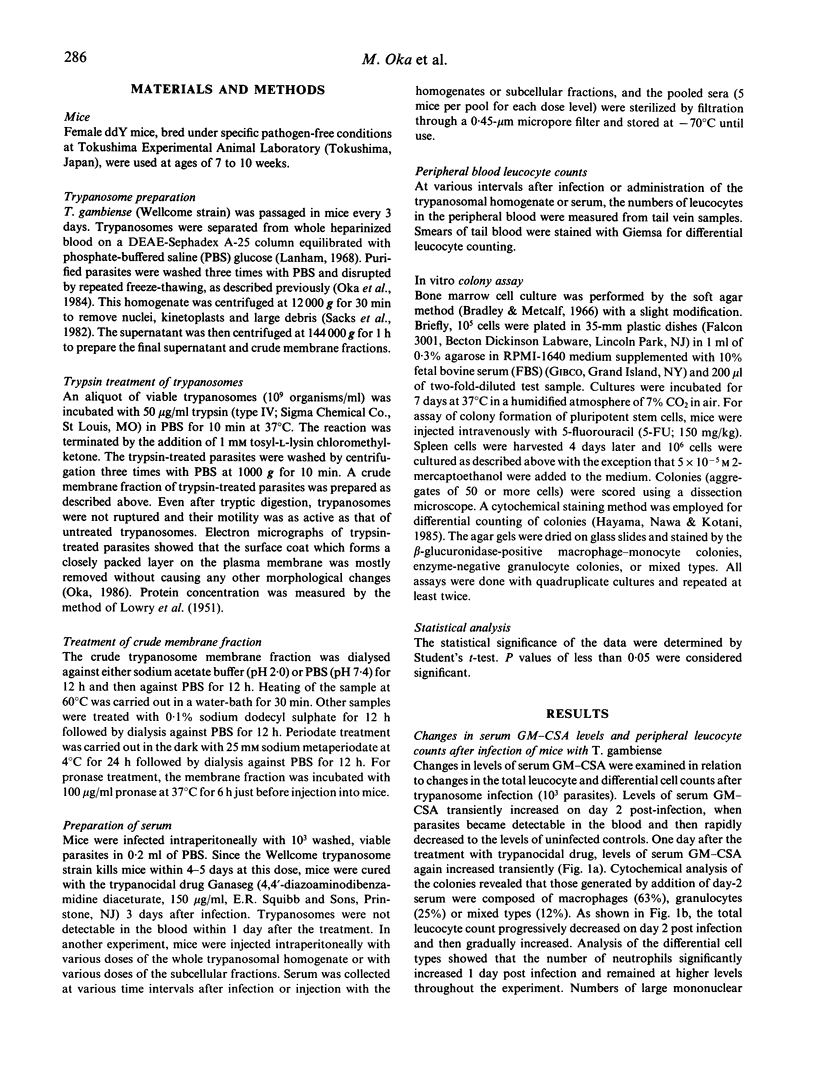
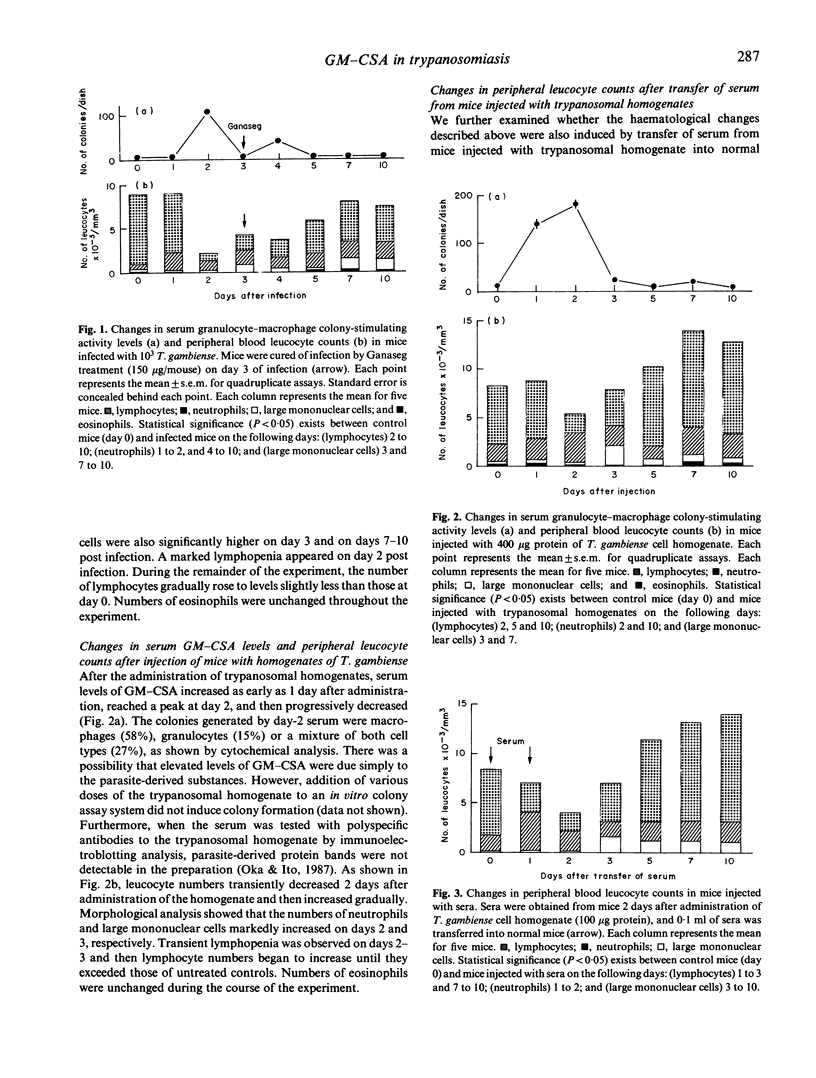

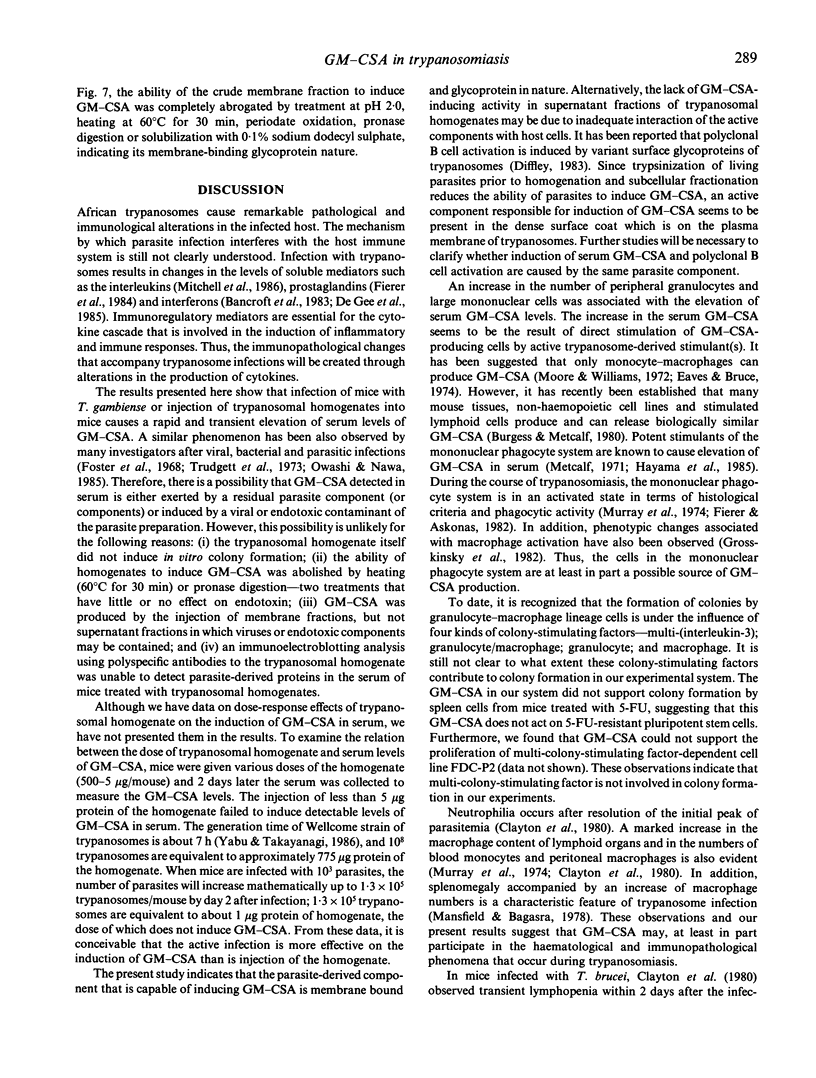
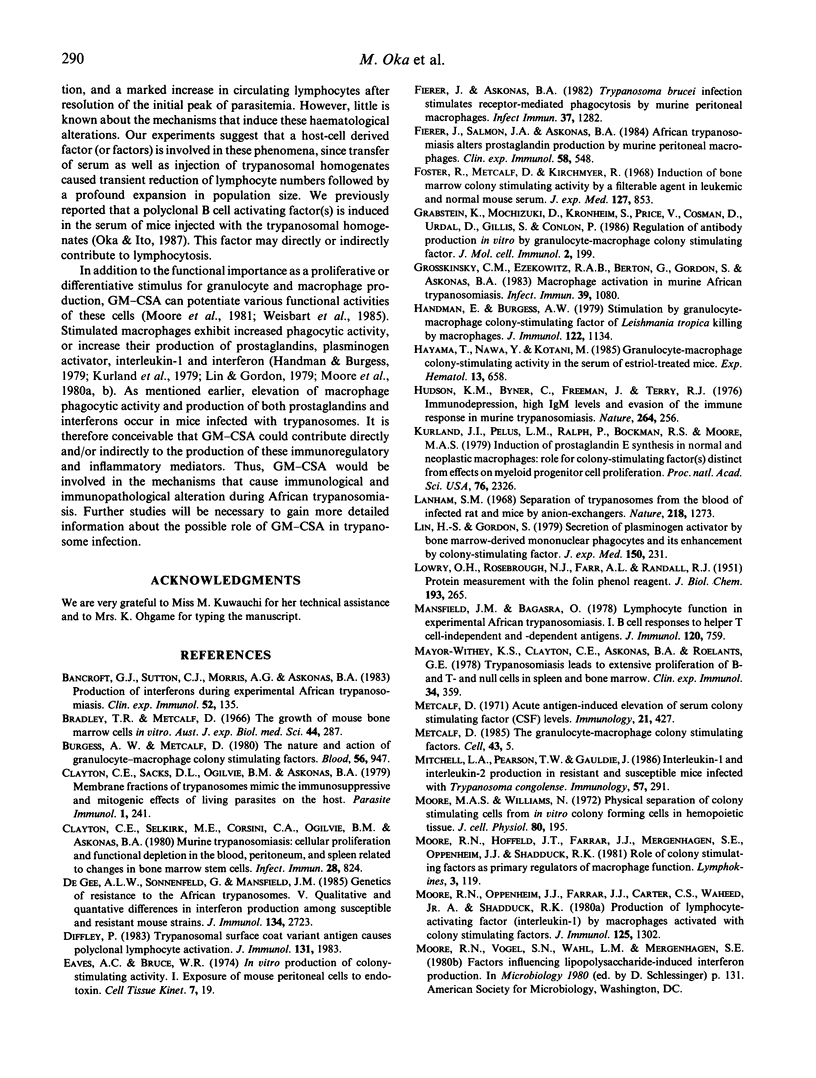
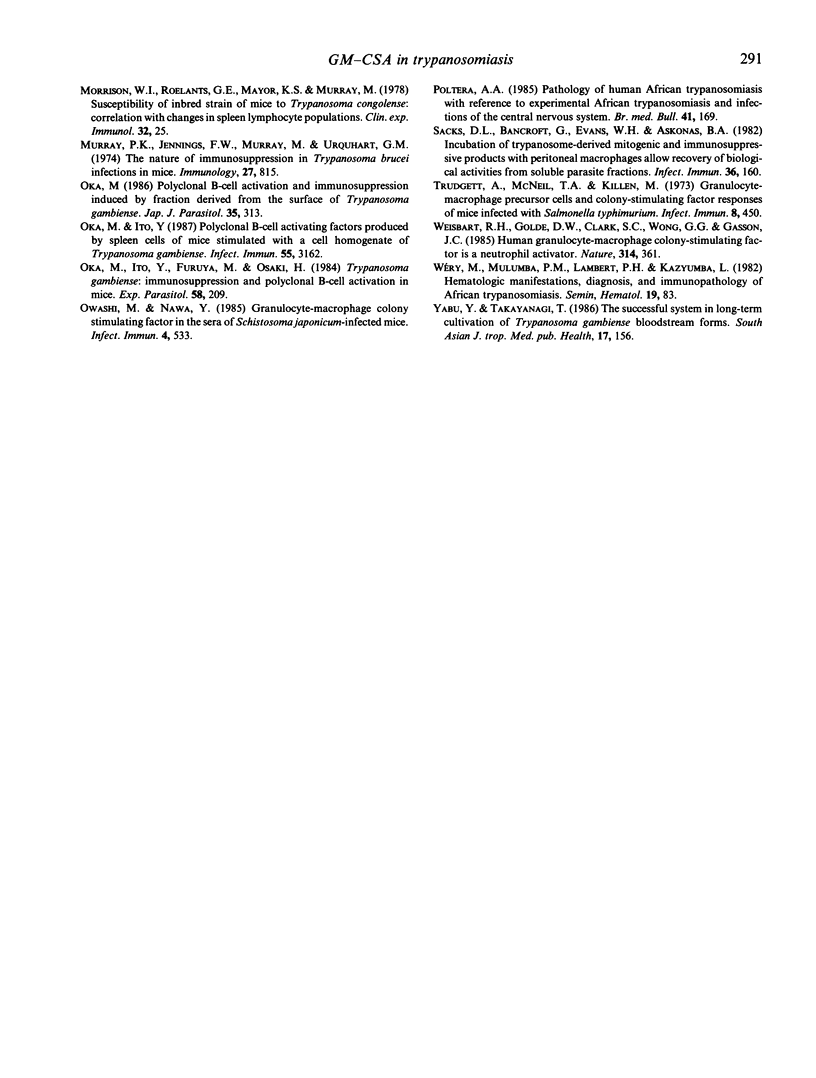
Selected References
These references are in PubMed. This may not be the complete list of references from this article.
- Bancroft G. J., Sutton C. J., Morris A. G., Askonas B. A. Production of interferons during experimental African trypanosomiasis. Clin Exp Immunol. 1983 Apr;52(1):135–143. [PMC free article] [PubMed] [Google Scholar]
- Bradley T. R., Metcalf D. The growth of mouse bone marrow cells in vitro. Aust J Exp Biol Med Sci. 1966 Jun;44(3):287–299. doi: 10.1038/icb.1966.28. [DOI] [PubMed] [Google Scholar]
- Burgess A. W., Metcalf D. The nature and action of granulocyte-macrophage colony stimulating factors. Blood. 1980 Dec;56(6):947–958. [PubMed] [Google Scholar]
- Clayton C. E., Sacks D. L., Ogilvie B. M., Askonas B. A. Membrane fractions of trypanosomes mimic the immunosuppressive and mitogenic effects of living parasites on the host. Parasite Immunol. 1979 Autumn;1(3):241–249. doi: 10.1111/j.1365-3024.1979.tb00709.x. [DOI] [PubMed] [Google Scholar]
- Clayton C. E., Selkirk M. E., Corsini C. A., Ogilvie B. M., Askonas B. A. Murine trypanosomiasis: cellular proliferation and functional depletion in the blood, peritoneum, and spleen related to changes in bone marrow stem cells. Infect Immun. 1980 Jun;28(3):824–831. doi: 10.1128/iai.28.3.824-831.1980. [DOI] [PMC free article] [PubMed] [Google Scholar]
- Diffley P. Trypanosomal surface coat variant antigen causes polyclonal lymphocyte activation. J Immunol. 1983 Oct;131(4):1983–1986. [PubMed] [Google Scholar]
- Eaves A. C., Bruce W. R. In vitro production of colony-stimulating activity. I. Exposure of mouse peritoneal cells to endotoxin. Cell Tissue Kinet. 1974 Jan;7(1):19–30. doi: 10.1111/j.1365-2184.1974.tb00395.x. [DOI] [PubMed] [Google Scholar]
- Fierer J., Askonas B. A. Trypanosoma brucei infection stimulates receptor-mediated phagocytosis by murine peritoneal macrophages. Infect Immun. 1982 Sep;37(3):1282–1284. doi: 10.1128/iai.37.3.1282-1284.1982. [DOI] [PMC free article] [PubMed] [Google Scholar]
- Fierer J., Salmon J. A., Askonas B. A. African trypanosomiasis alters prostaglandin production by murine peritoneal macrophages. Clin Exp Immunol. 1984 Dec;58(3):548–556. [PMC free article] [PubMed] [Google Scholar]
- Foster R., Jr, Metcalf D., Kirchmyer R. Induction of bone marrow colony-stimulating activity by a filterable agent in leukemic and normal mouse serum. J Exp Med. 1968 May 1;127(5):853–866. doi: 10.1084/jem.127.5.853. [DOI] [PMC free article] [PubMed] [Google Scholar]
- Grabstein K., Mochizuki D., Kronheim S., Price V., Cosman D., Urdal D., Gillis S., Conlon P. Regulation of antibody production in vitro by granulocyte-macrophage colony stimulating factor. J Mol Cell Immunol. 1986;2(4):199–207. [PubMed] [Google Scholar]
- Grosskinsky C. M., Ezekowitz R. A., Berton G., Gordon S., Askonas B. A. Macrophage activation in murine African trypanosomiasis. Infect Immun. 1983 Mar;39(3):1080–1086. doi: 10.1128/iai.39.3.1080-1086.1983. [DOI] [PMC free article] [PubMed] [Google Scholar]
- Handman E., Burgess A. W. Stimulation by granulocyte-macrophage colony-stimulating factor of Leishmania tropica killing by macrophages. J Immunol. 1979 Mar;122(3):1134–1137. [PubMed] [Google Scholar]
- Hayama T., Nawa Y., Kotani M. Granulocyte-macrophage colony-stimulating activity in the serum of estriol-treated mice. Exp Hematol. 1985 Aug;13(7):658–663. [PubMed] [Google Scholar]
- Hudson K. M., Byner C., Freeman J., Terry R. J. Immunodepression, high IgM levels and evasion of the immune response in murine trypanosomiasis. Nature. 1976 Nov 18;264(5583):256–258. doi: 10.1038/264256a0. [DOI] [PubMed] [Google Scholar]
- Kurland J. I., Pelus L. M., Ralph P., Bockman R. S., Moore M. A. Induction of prostaglandin E synthesis in normal and neoplastic macrophages: role for colony-stimulating factor(s) distinct from effects on myeloid progenitor cell proliferation. Proc Natl Acad Sci U S A. 1979 May;76(5):2326–2330. doi: 10.1073/pnas.76.5.2326. [DOI] [PMC free article] [PubMed] [Google Scholar]
- LOWRY O. H., ROSEBROUGH N. J., FARR A. L., RANDALL R. J. Protein measurement with the Folin phenol reagent. J Biol Chem. 1951 Nov;193(1):265–275. [PubMed] [Google Scholar]
- Lanham S. M. Separation of trypanosomes from the blood of infected rats and mice by anion-exchangers. Nature. 1968 Jun 29;218(5148):1273–1274. doi: 10.1038/2181273a0. [DOI] [PubMed] [Google Scholar]
- Lin H. S., Gordon S. Secretion of plasminogen activator by bone marrow-derived mononuclear phagocytes and its enhancement by colony-stimulating factor. J Exp Med. 1979 Aug 1;150(2):231–245. doi: 10.1084/jem.150.2.231. [DOI] [PMC free article] [PubMed] [Google Scholar]
- Mansfield J. M., Bagasra O. Lymphocyte function in experimental African trypanosomiasis. I. B cell responses to helper T cell-independent and -dependent antigens. J Immunol. 1978 Mar;120(3):759–765. [PubMed] [Google Scholar]
- Mayor-Withey K. S., Clayton C. E., Roelants G. E., Askonas B. A. Trypanosomiasis leads to extensive proliferation of B, T and null cells in spleen and bone marrow. Clin Exp Immunol. 1978 Dec;34(3):359–363. [PMC free article] [PubMed] [Google Scholar]
- Metcalf D. Acute antigen-induced elevation of serum colony stimulating factor (CFS) levels. Immunology. 1971 Sep;21(3):427–436. [PMC free article] [PubMed] [Google Scholar]
- Metcalf D. The granulocyte-macrophage colony stimulating factors. Cell. 1985 Nov;43(1):5–6. doi: 10.1016/0092-8674(85)90004-2. [DOI] [PubMed] [Google Scholar]
- Mitchell L. A., Pearson T. W., Gauldie J. Interleukin-1 and interleukin-2 production in resistant and susceptible inbred mice infected with Trypanosoma congolense. Immunology. 1986 Feb;57(2):291–296. [PMC free article] [PubMed] [Google Scholar]
- Moore M. A., Williams N. Physical separation of colony stimulating cells from in vitro colony forming cells in hemopoietic tissue. J Cell Physiol. 1972 Oct;80(2):195–206. doi: 10.1002/jcp.1040800206. [DOI] [PubMed] [Google Scholar]
- Moore R. N., Oppenheim J. J., Farrar J. J., Carter C. S., Jr, Waheed A., Shadduck R. K. Production of lymphocyte-activating factor (Interleukin 1) by macrophages activated with colony-stimulating factors. J Immunol. 1980 Sep;125(3):1302–1305. [PubMed] [Google Scholar]
- Morrison W. I., Roelants G. E., Mayor-Withey K. S., Murray M. Susceptibility of inbred strains of mice to Trypanosoma congolense: correlation with changes in spleen lymphocyte populations. Clin Exp Immunol. 1978 Apr;32(1):25–40. [PMC free article] [PubMed] [Google Scholar]
- Murray P. K., Jennings F. W., Murray M., Urquhart G. M. The nature of immunosuppression in Trypanosoma brucei infections in mice. I. The role of the macrophage. Immunology. 1974 Nov;27(5):815–824. [PMC free article] [PubMed] [Google Scholar]
- Oka M., Ito Y., Furuya M., Osaki H. Trypanosoma gambiense: immunosuppression and polyclonal B-cell activation in mice. Exp Parasitol. 1984 Oct;58(2):209–214. doi: 10.1016/0014-4894(84)90036-5. [DOI] [PubMed] [Google Scholar]
- Oka M., Ito Y. Polyclonal B-cell-activating factors produced by spleen cells of mice stimulated with a cell homogenate of Trypanosoma gambiense. Infect Immun. 1987 Dec;55(12):3162–3167. doi: 10.1128/iai.55.12.3162-3167.1987. [DOI] [PMC free article] [PubMed] [Google Scholar]
- Owhashi M., Nawa Y. Granulocyte-macrophage colony-stimulating factor in the sera of Schistosoma japonicum-infected mice. Infect Immun. 1985 Sep;49(3):533–537. doi: 10.1128/iai.49.3.533-537.1985. [DOI] [PMC free article] [PubMed] [Google Scholar]
- Poltera A. A. Pathology of human African trypanosomiasis with reference to experimental African trypanosomiasis and infections of the central nervous system. Br Med Bull. 1985 Apr;41(2):169–174. doi: 10.1093/oxfordjournals.bmb.a072045. [DOI] [PubMed] [Google Scholar]
- Sacks D. L., Bancroft G., Evans W. H., Askonas B. A. Incubation of trypanosome-derived mitogenic and immunosuppressive products with peritoneal macrophages allows recovery of biological activities from soluble parasite fractions. Infect Immun. 1982 Apr;36(1):160–168. doi: 10.1128/iai.36.1.160-168.1982. [DOI] [PMC free article] [PubMed] [Google Scholar]
- Trudgett A., McNeill T. A., Killen M. Granulocyte-macrophage precursor cell and colony-stimulating factor responses of mice infected with Salmonella typhimurium. Infect Immun. 1973 Sep;8(3):450–455. doi: 10.1128/iai.8.3.450-455.1973. [DOI] [PMC free article] [PubMed] [Google Scholar]
- Weisbart R. H., Golde D. W., Clark S. C., Wong G. G., Gasson J. C. Human granulocyte-macrophage colony-stimulating factor is a neutrophil activator. 1985 Mar 28-Apr 3Nature. 314(6009):361–363. doi: 10.1038/314361a0. [DOI] [PubMed] [Google Scholar]
- Yabu Y., Takayanagi T. The successful system in long-term cultivation of Trypanosoma gambiense bloodstream forms. Southeast Asian J Trop Med Public Health. 1986 Jun;17(2):156–164. [PubMed] [Google Scholar]
- de Gee A. L., Sonnenfeld G., Mansfield J. M. Genetics of resistance to the African trypanosomes. V. Qualitative and quantitative differences in interferon production among susceptible and resistant mouse strains. J Immunol. 1985 Apr;134(4):2723–2726. [PubMed] [Google Scholar]


